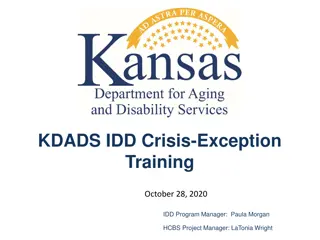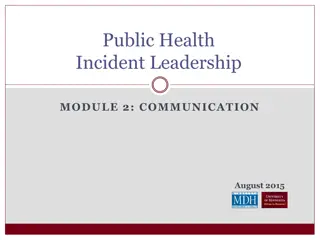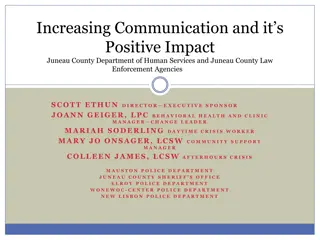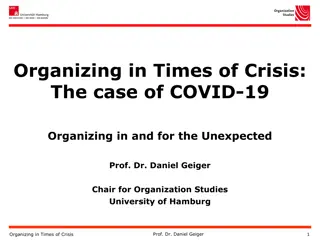Crisis Communication in Africa: Strategies and Response
Explore the key principles of crisis communication in Africa through expert insights and quotes. Learn about crisis response strategies, the importance of accurate information dissemination, and steps for effective crisis management. Discover the significance of the "Golden Hour" and surviving the initial 48 hours in a crisis situation.
Download Presentation

Please find below an Image/Link to download the presentation.
The content on the website is provided AS IS for your information and personal use only. It may not be sold, licensed, or shared on other websites without obtaining consent from the author. Download presentation by click this link. If you encounter any issues during the download, it is possible that the publisher has removed the file from their server.
E N D
Presentation Transcript
Crisis Communication in Africa Crisis Response & Strategies Ibrahim Saleh, PhD Ibrahim.Saleh@uct.ac.za
"There cannot be a crisis next week My schedule is already full." -Henry Kissinger
"Providing the right amount of accurate information at the right time is a fundamentally strategic issue." Gerald Baron
Close scrutiny will show that most "crisis situations" are opportunities to either advance, or stay where you are . -Maxwell Malt 4
Readings Week 3: Hale, J. E. & Dulek, R. E. (2005). "Crisis Response Communication Challenges: Building Theory From Qualitative Data," Journal of Business Communication, 42(2), (April 2005):112- 134. Law, A. & McNeish W. (2007). "Contesting the New Irrational Actor Model: A Case Study of Mobile Phone Mast Protest, " Journal of Sociology, 41(3): 439 456.
Nine Steps of Crisis Response Organize assignments Conduct assessment (activate crisis plan) Prepare information and obtain approvals 3 4 5 Release information to media, public, partners through arranged channels Conduct notification 2 6 1 Verify situation Crisis Occurs 7 Obtain feedback and conduct crisis evaluation 8 Conduct public education 9 Monitor events
The "Golden Hour" If you have a crisis communications plan, activate it Holding statement Statements should be 75 100 words. 'This is what we know now but we re continuing to investigate and will keep you informed' 'No comment ' isn t an option Your job is to: Get correct information out simultaneously; Let them know what you know and can say; Get critical public safety messages out; Correct rumors; Educate and calm the public; and Gain support 7
Surviving the First 48 Hours Requires quick assessment Collection of facts Actions to secure resources Media and public response Rehearsal Alert key partners, as appropriate 48
Key Messages Prepare to address these questions: Who: is responsible, is affected, will benefit What: happened, is the impact, is the cost, is the solution When: did it happened, will it be resolved, will you have more information Where: did it happen, are people going to be relocated Why: didn t you know about this, didn t you do something sooner, is this taking so long "Why " questions tempt you to speculate - don t do it! 9
Delivering Bad News Getting out your message puts you on offense, not defense. Answer honestly can t play gotcha if you tell the truth Take responsibility Show humility Couple concern with commitment to action Address rumors Make sure your body language corresponds to your message 10
Instances of Crisis How would you report on cases reflected in the following images?
Thesis statement The attribution of whatever has caused a crisis not only affects how the crisis is perceived and also how communicating the crisis is shaped. Public response tend to be dependent on the cause of the risk, even though the consequence is the same.
Communicating Crisis How to best communicate to different audiences during a crisis seems to be high on the political agenda. Information released in times of crises often needs to be timely, accurate and should provide relevant information to those affected. The content of crisis communication is influenced by the type of crisis is at hand; ranging from public apologies when the reputation of an organization is at stake, to emergency behaviour in case of a major natural disaster.
Crisis Communication: Past to Present In the past, crisis communication focused on causes and who or what that is to be blamed, as a way of reducing threat and uncertainty (Seeger, 2002). In the present, the causes leading to a crisis are unclear or unknown, communicating uncertainty and ambiguity is focused on the best practice of crisis communication.
In the past, authorities have been reluctant to share information concerning different risks and crises out of concern that the public, or groups of people, might react with protests, irrational behaviour or even panic (Perry & Lindell, 2003; Sandman, 2006). In the present, communication acknowledges or attributes the cause of the risk or crisis, because it provides the context for the situation (Coombs & Holladay, 1996).
Risk-managing process Providing people with detailed information concerning the events leading up to a crisis can cause them to believe that the risk could have been better managed or that the crisis could have been altogether avoided (Coombs, 1999). However, many risk managers don t disclose the risk assessment process to a larger scrutiny, as it may invite discussions of overall risks rather than those controlled by the individual company, leading to delays or costly processes (Gouldson, Lidskog, & WesterHerber, 2007; Wise en & Wester-Herber, 2007)
Psychometric Paradigm (Fischhoff, Slovic, Lichtenstein, Read, & Combs, 1978). The level, the intensity and the direction of perceived shared risk depend to a large extent on the degree of 'dread' it invokes (Sjo berg, 2002), it can be agreed upon that risk perception is more influenced by possible consequences, rather than the estimated probability (Sjo berg, 2002). Risk is a multi-dimensional concept that is not primarily focused on the probabilities and technical estimates, but also on the level of 'outrage' factor that include cognitive and affective components in emergency situations (Lachlan & Spence, 2007)
Organizational crises Events characterized by high consequence, low probability, ambiguity, and decision-making time pressure (Pearson & Clair, 1998). Crisis management consists of three distinct phases: crisis prevention, crisis response, and recovery from the crisis. Fink (1986) subdivided crisis prevention (i.e., avoiding and averting potential crises) into three stages (mitigation, planning, and warning), thus developing his five-stage interdependent model consisting of crisis mitigation, planning, warning, response, and recovery. The response stage is entered when avoidance efforts fail and events trigger a crisis, which makes the shift in resources and efforts to minimizing damage to the environment, facilities, and people. Crisis response communication includes conveying ongoing crisis events to stakeholders, decision making within the crisis management team, and organizational decisions regarding whether and what amount of information to share
The Spiral Crisis Response Communication Model The crisis response communication spiral is activated when a triggering event occurs and rapid, decisive action is needed. At this point, the organization goes into "crisis mode" and proceeds to enter the crisis response stage. The process progresses forward through the loop from (1)observation through (2) dissemination, which in turn triggers another response (3) iteration. At other times, however, analysis shows that progress ceases and the crisis teams retrace the communication activities by moving backward. Information is made sense of is determined by concrete environmental and social conditions that people find themselves in
The perception and the Reality The controversy and related protests surrounding the sitting of mobile telecommunications base stations are understood primarily in terms of perceptions of health risks associated with radiation emissions then they rest on an apparent paradox. However, scientific evidence, radiation from base station masts could be considerably lower than emissions from mobile handsets (Stewart, 2000)
The New Irrational Actor Model Current research tends to prioritize professional and expert definitions and calculations of risk over public perceptions (Bennett and Calman, 1999; Kammen and Hassenzahl, 1999). Public concerns and campaigns are variously attributed to the failure of elites to communicate scientific knowledge effectively to the public (Covello, 1998), or their collective cognitive failure to acquire accurate knowledge (Hester, 1998).
The 'established mental model' of deficient public knowledge and risk perceptions often assumes the public s numerous misconceptions and misperceptions, as well as deductions from inaccurate media information (Szmigielski and Sobiczewska, 2000: 364). Studies for the International Commission on Non- Ionizing Radiation (ICNIR) and the World Health Organization (WHO) (Matthes et al., 1998; Repacholi and Muc, 1999) propose to resolve the clash between science and public perceptions by a more efficiently designed process for communicating scientific knowledge appropriate to the existing 'mental models' of lay people.
The Explicit Irrationality Thesis Risk-denial perspective, constantly hostile to environmentalism and related social movements and discourses that seek to challenge the hegemony of dominant conceptions of scientific endeavour, economic modernization and technological development (Burgess, 2002, 2004, 2005a, 2005b). Contemporary society is increasingly losing confidence in scientific authority, the benefits of corporate governance and the progressive potential for human advancement have led to the model of 'march of unreason'(Burgess, 2004; Furedi, 1997)
Media and the Irrational Model Media play a decisive role as the catalyst of fear, and state elites engage in a collusive 'politics of fear', something that is illustrated in the way that scientific authority is routinely either under used or over used by state elites depending on the sensitivity of the political issue at stake (Brown, 2005). Media with agenda setting has a tendency to transform through cumulative effects fear into a cultural perspective through which society makes sense of itself (Furedi, 2004: 3).
The precautionary principle Represents for the campaigners the most substantively rational response to unknown and unseen risks rather than an irrational 'gamble' on 'irreversible' consequences. Activists therefore seek for the precautionary approach to be moved from the level of rhetoric to real implementation by the government and planning authorities.
This presentation is licenced under the Creative Commons Attribution 2.5 South Africa License. To view a copy of this licence, visit http://creativecommons.org/licenses/by-sa/2.5/za/ Or send a letter to Creative Commons, 171 Second Street, Suite 300, San Francisco, California 94105, USA.























